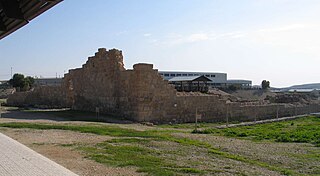Adummim is a place-name mentioned in the biblical Book of Joshua in connection with the ascent of Adummim.

A caravanserai was a roadside inn where travelers (caravaners) could rest and recover from the day's journey. Caravanserais supported the flow of commerce, information and people across the network of trade routes covering Asia, North Africa and Southeast Europe, most notably the Silk Road. Although many were located along rural roads in the countryside, urban versions of caravanserais were also historically common in cities throughout the Islamic world, though they were often called by other names such as khan, wikala, or funduq.

Khan el-Khalili is a famous bazaar and souq in the historic center of Cairo, Egypt. Established as a center of trade in the Mamluk era and named for one of its several historic caravanserais, the bazaar district has since become one of Cairo's main attractions for tourists and Egyptians alike. It is also home to many Egyptian artisans and workshops involved in the production of traditional crafts and souvenirs. The name Khan el-Khalili historically referred to a single building in the area; today it refers to the entire shopping district.

Gesher is a kibbutz in the Beit She'an Valley in northeastern Israel. Founded in 1939 by Jewish refugees from Germany, it falls under the jurisdiction of Valley of Springs Regional Council. It is situated 10 km south of kibbutz Deganya Aleph and 15 km south of Tiberias. The population is approximately 500 inhabitants.

Deir El Ahmar is a Lebanese town, located 100 km from Beirut and 22 km northwest of Baalbek in the Bekaa Valley in Lebanon.

Minya Governorate is one of the governorates of Upper Egypt. Its capital city, Minya, is located on the left bank of the Nile River.

Mata is a moshav in central Israel. Located in the Jerusalem corridor near Beit Shemesh, it falls under the jurisdiction of Mateh Yehuda Regional Council. In 2019 it had a population of 896.

The Monastery of Euthymius started as a lavra-type monastic settlement in the Judaean desert, founded by Saint Euthymius the Great (377–473) in 420, known as the Laura or Lavra of Euthymius. After its final abandonment in the 13th century, it was repurposed as a caravanserai and became known as Khan el-Ahmar, the Red Caravanserai, khan being an originally Persian word for inn or caravanserai. Its ruins still stand a short distance south of today's main Jerusalem-Jericho highway in the West Bank.

Khan al-Umdan is the largest and best preserved caravanserai in Acre, Israel. Located in the Old City of Acre, it is one of the prominent projects constructed during the rule of Ahmed Jezzar Pasha in Galilee, under the Ottoman era.

al-Tujjar Caravansarai are the ruins of a caravanserai in the Lower Galilee, Israel, opposite the entrance to Beit Keshet.
The production and consumption of wine has been widespread in the Middle East and has been tolerated to varying extents by different religious groups. Islam forbade all intoxicants (khamr) and even pressed grape juice for Muslims. Wine was traded and used among the Jews, at least in Egypt, including for sacramental purposes, and had to be prepared by Jews according to stated practices. Many Christian monasteries in the region made and sold wine to raise revenue. Finally, the Zoroastrian communities of Persia continued to make and drink wine after the Islamic conquest.

Khirbat Al-Burj was a former Palestinian village, depopulated in 1948. Presently, Khirbat Al-Burj or Burj Binyamina is a ruined stone-built structure in the Sharon Plain 1 km south of Binyamina from the Ottoman period, situated at a crossroads and believed to be either a mansion connected to an estate, a fortified farmhouse, or a khan (caravanserai).

Al-Ras al-Ahmar was a Palestinian Arab village in the Safad Subdistrict. It was depopulated during the 1948 Arab–Israeli War on October 30, 1948, by the Israeli 7th Armored Brigade during Operation Hiram. It was located 8.5 km north of Safad.

Khan al-Ahmar is a Palestinian village located in the Khan al-Ahmar area of the Jerusalem Governorate of the West Bank. In 2018, there were between 173 and 180 Bedouin, including 92 children, living there in tents and huts, upwards of 100 in 2010, with its local school serving the needs of 150 children in the area. Khan al-Ahmar is located between the Israeli settlements of Ma'ale Adumim and Kfar Adumim on the north side of Highway 1, between the junctions with Route 437 and Route 458.
Ahmar or Al Ahmar (الاحمر) may refer to:

Khan al-Sabil is a village in northwestern Syria, administratively part of Idlib District of the Idlib Governorate, located south of Idlib. It is situated on either side of the Aleppo-Damascus highway, just east of the Jabal Zawiya mountain. Nearby localities include Maarrat al-Nu'man and Babila to the south, Masaran to the southeast, Shaykh Idris to the east, Maardibsah, Mardikh and Saraqib to the north and Kafr Battikh to the northwest.

Funduq al-Najjarin is a historic funduq in Fes el Bali, the old medina quarter in the city of Fez, Morocco.

Khan al-Hatruri, known in Western terms as the Inn of the Good Samaritan, is a ruined former caravanserai located on the road between Jerusalem and Jericho, 298 meters above sea level. It now houses a museum of ancient mosaics and other archaeological findings from the Palestinian territories, the West Bank and the Gaza Strip. Historically, the hill dominating the caravansary site from the northeast was repeatedly fortified, and traveller inns were built a little below the hilltop. This is reflected in the presence of two distinct, if related, archaeological sites in close proximity to each other, although today they are separated by the modern Jerusalem–Jericho highway.














